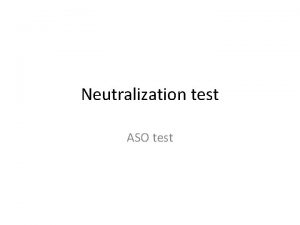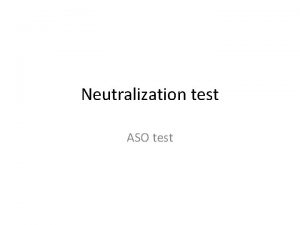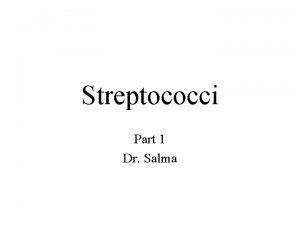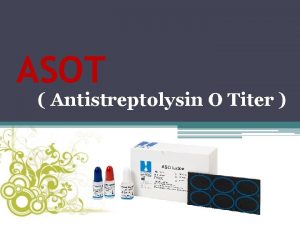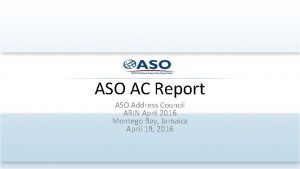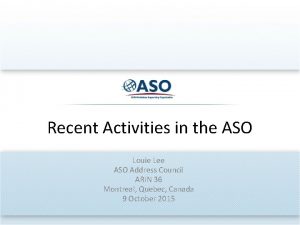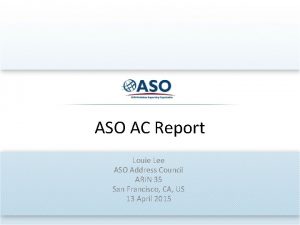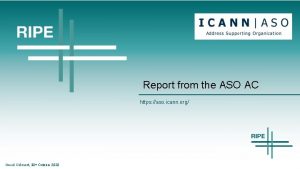ANTISTREPTOLYSINO ASO TEST THE ASO IS USED TO







- Slides: 7

ANTI-STREPTOLYSIN-O (ASO) TEST THE ASO IS USED TO DEMONSTRATE THE BODY'S REACTION TO AN INFECTION CAUSED BY GROUP A BETA-HEMOLYTIC STREPTOCOCCI. GROUP A STREPTOCOCCI PRODUCE THE ENZYME STREPTOLYSIN O, WHICH CAN DESTROY (LYSE) RED BLOOD CELLS. ANTI-STREPTOLYSIN O (ASO OR ASLO) IS THE ANTIBODY MADE AGAINST STREPTOLYSIN O, AN IMMUNOGENIC, OXYGEN-LABILE HEMOLYTIC TOXIN PRODUCED BY MOST STRAINS OF GROUP A AND MANY STRAINS OF GROUPS C AND G STREPTOCOCCI. THE O IN THE NAME STANDS FOR OXYGEN-LABILE; THE OTHER RELATED TOXIN BEING OXYGEN-STABLE STREPTOLYSIN-S. THE MAIN FUNCTION OF STREPTOLYSIN O IS TO CAUSE HEMOLYSIS (THE BREAKING OPEN OF RED BLOOD CELLS) IN PARTICULAR, BETAHEMOLYSIS.

• Species of Streptococcus are classified based on their hemolytic properties. Alpha-hemolytic species cause oxidization of iron in hemoglobin molecules within red blood cells, giving it a greenish color on blood agar like S. pneumoniae and viridans streptococci. Beta-hemolytic species cause complete rupture of red blood cells. On blood agar, this appears as wide areas clear of blood cells surrounding bacterial colonies like S. pyogenes and S. agalactiae. Gamma-hemolytic species cause no hemolysis like. • Beta-hemolytic streptococci are further classified by Lancefield grouping, a serotype classification (that is, describing specific carbohydrates present on the bacterial cell wall). The 20 described serotypes are named Lancefield groups A to V (excluding I and J).

• Principle ASO test method is based on an immunologic reaction between Streptococcal antigens bound to biologically latex particles and streptococcal antibodies in the test sample. Visible agglutination occurs when increased antibody level, are present in the test specimen.

• Normal ASO levels for preschool children are generally less than 100 IU/ml, but levels rise with age, peaking in school age and decreasing in adulthood. • Elevated ASO titers may associated with ankylosing, spondylitis, glomerulonephritis, scarlet fever and tonsillitis. Increased ASO levels are generally not found in sera of patients with rheumatoid arthritis except during acute episodes. • Extremely low levels of ASO have been observed in the blood specimens of patients with nephrotic syndrome and antibody deficiency syndromes. • Patients on therapy of penicillin or other antibiotics may suppress a rise in ASO titer.

• Mechanism of action • These antibodies produced against the bacteria cross-react with human antigens (mainly collagen) and hence attack the cellular matrix of various organs, mainly the heart, joints, skin, brain, etc • • When is it performed? • Antibody appears in the blood serum one week to one month after the onset of a strep. infection. The diagnosis of a previous strep infection is confirmed when serial titers of ASO rise over a period of weeks, then fall slowly. ASO titers peak during the third week after the onset of acute symptoms of a streptococcal disease; at six months after onset, approximately 30% of patients exhibit abnormal titers. • As the infection subsides, the titer declines and returnes to normal levels after 6 months, if the titer not decrease, a recurrent or chronic infection may exist.

• Procedures: • Qualitative: • 1 -Allow each component to reach room temperature. • 2 -Gently shake the latex reagent to disperse the particles. • 3 - Add one drop of serum on to black circle test slide, using the disposable pipettes provided. • 4 - Add one drop of ASO latex reagent next to the drop of serum. • 5 - Mix both drops with a stirrer and spread over the entire area of the test circle. • 6 - Gently tilt or rotate the slide backwards and forwards for 2 minutes. Interpret results immediately after 2 minutes. Extended incubation may lead to false results. Positive and negative controls should be included at regular intervals.

Results +ve result: presence of agglutination indicates a level of ASO in the sample >200 IU/ml. -ve result: no agglutination indicates a level of ASO in the sample < 200 IU/ml. . Semi quantitative: This method can be performed in the same way as the qualitative test, using dilution of the serum in normal saline, phosphate buffered saline or glycine saline as below: 50 µl 50 µl + Serum 50 µl N. S 1: 2 1: 4 1: 8 1: 16 1: 32 Result: The serum titer is examined as the reciprocal of the highest dilution showing macroscopic agglutination, e. g. If this occurs in dilution 2, the titer is 800 IU/ml. . Notes: The ASO-latex has been standardized to detect serum ASO levels at or above 200 IU/ml. , which is considered the lowest concentration of clinical significance.
